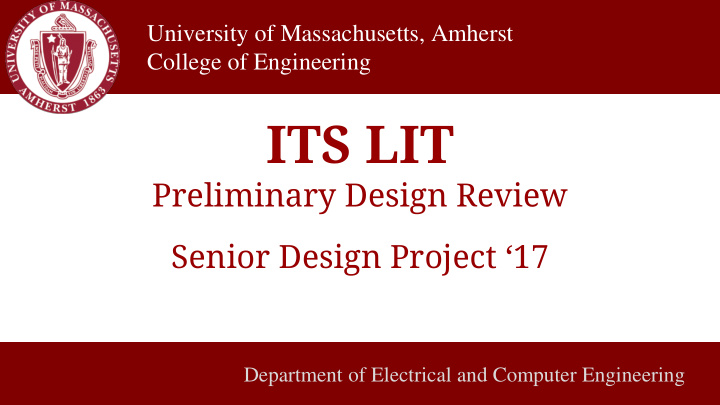



University of Massachusetts, Amherst College of Engineering ITS LIT Preliminary Design Review Senior Design Project ‘17 Department of Electrical and Computer Engineering
Meet The Team Advisor: Professor David McLaughlin Varun Tommy Zhen Michael Polin Patrick Browne Emma Bryce Menon CSE CSE EE EE EE
ITS LIT Interactive Timed Synchronized Lights In Technicolor
Goal Create a semi-permanent nighttime LED display mounted on a window at DuBois Library or the Old Chapel that exhibits LGBT+ pride-related images amongst other presets that are controlled by the public through a mobile app.
Problem ● Discrimination against LGBT+ students and other groups ● Invisibility and erasure of identities ● Out at school but not at home ● Coming out in college ● “Otherness”
Problem
Application & Impact Social Impact: ● Fosters and sends message of LGBT inclusion ● Attracts visiting HS students and current UMass students to ECE ● Cultivates campus wide cohesiveness ● “Gives back” to campus community
Application & Impact Personal Impact: ● Interactive decorative display ● App allows users to dynamically change and update the panel ● Potential to replace posters and tapestries in dorm rooms
Requirements ● App ● Server monitored by controller ● Limited delay ● Query ● Display should be of a size that can be viewed clearly from below —around 3’ x 3’ ● Complete set of LGBT+ pride flags
Block Diagram
Block 1: App ● The interactive app will allow users to choose from a host of presets to change the designs on the LED panel ○ Easy navigation ○ Real time communication between app, server and microcontroller ○ Wifi protocols ● The app will send the image to a server, which in turn communicates with the microcontroller ● Option to add administrator who can add custom images
Block 1: App Queuing ● App will be available for download on respective app store ● Users will be able to change presets as they pass by the public installation ● App handles requests based on timing 0f request ● Consecutive requests will be stored in a queue ● There will be a ‘minimum time’ before the preset is changed ● App also handles overloading, and makes sure one preset doesn’t dominate
Block 1: App ● We will have one app complete and if time permits, we will develop the second one as well iOS App Android App ● Will be developed using Swift ● Will be developed using (similar to objective C) Android SDK
Block 2: Server ● Provide temporary storage for presets/commands between app and controller ● Handles potential traffic if multiple users input at similar times
Block 3: Microcontroller ● Accepts input from the server ● Connects to wifi ● Must be able to accept an image and reformat it to fit our panel size ● Must also be able to coordinate the panels to display the image accepted ● Must have enough processing power
Block 4: LED Array Panel ● Receives input from the microcontroller ● 32 by 32 or 64 by 64 LED’s ● Displays the picture by using each LED as a pixel ● Use multiple panels that can be daisy chained together to form a bigger panel ● Installed Indoors ● Pixel Pitch(Resolution)
Cost
Design Alternatives ● Controller ○ Raspberry Pi vs Beaglebone ● Server ○ Third Party Server vs UMass Server ● App ○ iOS vs Android ● Ethernet vs WiFi
MDR Deliverables ● Microcontroller drives display on LED array ○ Display can be controlled via laptop ● Server created ○ Microcontroller interaction tested ● Basic app functionality ○ GUI and user input ● Beginning vetting with school or faculty member
Questions?
Recommend
More recommend